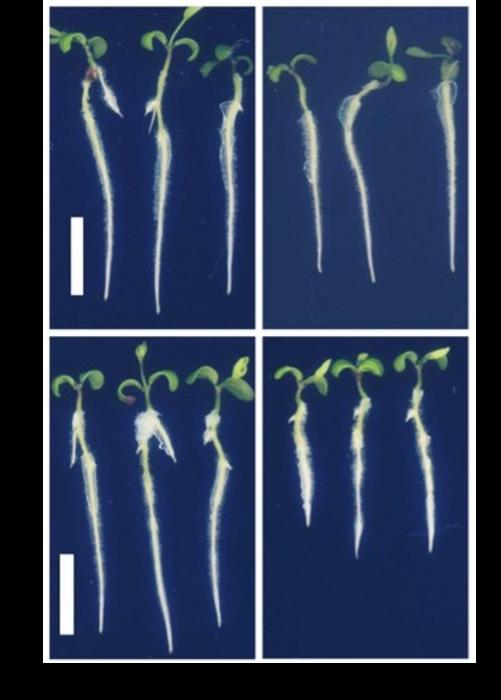LA JOLLA (July 18, 2024)—The negative impact of human activity on Earth doesn’t just affect our planet’s atmosphere—it goes much deeper, into its soils. For instance, excessive application of manure or sewage sludge can increase heavy metal concentrations in agricultural land where vital crops are grown. One of these heavy metals is zinc, a micronutrient necessary for plant and animal health. In excess, however, zinc can be extremely damaging to sensitive plant species.

Credit: Salk Institute
LA JOLLA (July 18, 2024)—The negative impact of human activity on Earth doesn’t just affect our planet’s atmosphere—it goes much deeper, into its soils. For instance, excessive application of manure or sewage sludge can increase heavy metal concentrations in agricultural land where vital crops are grown. One of these heavy metals is zinc, a micronutrient necessary for plant and animal health. In excess, however, zinc can be extremely damaging to sensitive plant species.
Some plants have a naturally higher tolerance for zinc that allows them to thrive in otherwise toxic conditions, but the biology behind this was previously unclear. In a new study, Salk Institute scientists identified a gene that helps plants manage excess zinc in the soil.
The findings, published in Nature Communications on July 11, 2024, reveal that plants tolerate high levels of zinc by trapping it in their root cell walls, a process facilitated by a gene called trichome birefringence or TBR. Scientists and farmers can now use this information to develop and grow crops that are more resilient to soil contamination. Enhancing plant resilience is a major goal of Salk’s Harnessing Plants Initiative.
“The cell wall’s structure is like a scaffold that can store zinc away from the rest of the plant, and if the TBR gene is active, plants can store more zinc away,” explains senior author Wolfgang Busch, professor, executive director of the Harnessing Plants Initiative, and Hess Chair in Plant Science at Salk. “What’s interesting about this simple process is that it can be the difference between life and death for a plant exposed to toxic conditions.”
A cell wall’s capacity to store zinc is largely dependent on a process called pectin methylesterification—a process that alters the structure of the spongy pectin molecules inside cell walls so that they can absorb more zinc. To better understand this, the researchers performed a genome-wide association study to identify plant genes associated with increased pectin methylesterification.
“We found that TBR allele variants influence changes in pectin methylesterification and help determine a plant’s ability to tolerate higher zinc levels,” says first author Kaizhen Zhong, a former visiting graduate student in Busch’s lab. “Knowing this is really important because we can now potentially introduce or activate this gene in other plants to create crops that are more resilient to environmental changes.”
These initial experiments were performed in Arabidopsis thaliana, a small flowering plant that scientists use as a model organism for studying plant biology. The researchers’ next step was to see whether this gene works similarly in other plants, including important crop species.
To do this, the scientists placed Oryza sativa, a common strain of rice and staple crop for billions of people, in soil with toxic levels of zinc. They specifically compared two versions of Oryza—one with a functional TBR gene and one without—and monitored their root growth as a measure of zinc tolerance.
The rice with functional TBR thrived, confirming that this survival mechanism for zinc toxicity is conserved across multiple plant species. The same test was also done with the legume Lotus japonicus, producing the same result.
“What’s exciting is that our data suggest this phenomenon is conserved across all flowering plants, which make up the vast majority of plant species and food crops,” says Busch. “This one discovery could be applied to increase plant resilience to toxic levels of zinc and help to support our future food supply.”
With the world’s population projected to surge up to 11 billion by 2080 and the growing prevalence of zinc toxicity in our soils, it is imperative that progress be made to develop crops that can withstand these conditions. This study is an important step toward achieving that goal.
Other authors include Matthieu Pierre Platre, Wenrong He, Ling Zhang, Anna Małolepszy, and Min Cao of Salk; Peng Zhang, Xiangjin Wei, Shikai Hu, and Shaoqing Tang of the National Rice Research Institute in China; Baohai Li of Salk and Zhejiang University in China; and Peisong Hu of the National Rice Research Institute in China and Jiangxi Agricultural University.
The work was supported by Salk’s Hess Chair in Plant Science, the Zhejiang Provincial Natural Science Foundation of China (LDQ23C130001), the National Natural Science Foundation of China (32188102, 32071991), the Key Research and Development Program of Zhejiang Province (2020R51007, 2021C02056-1), and the National Natural Science Foundation of China (32172656).
About the Salk Institute for Biological Studies:
Unlocking the secrets of life itself is the driving force behind the Salk Institute. Our team of world-class, award-winning scientists pushes the boundaries of knowledge in areas such as neuroscience, cancer research, aging, immunobiology, plant biology, computational biology, and more. Founded by Jonas Salk, developer of the first safe and effective polio vaccine, the Institute is an independent, nonprofit research organization and architectural landmark: small by choice, intimate by nature, and fearless in the face of any challenge. Learn more at www.salk.edu.
Journal
Nature Communications
Article Title
Natural variation of TBR confers zinc toxicity tolerance in plants through modulating root cell wall pectin methylesterification
Article Publication Date
11-Jul-2024



